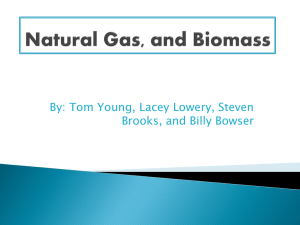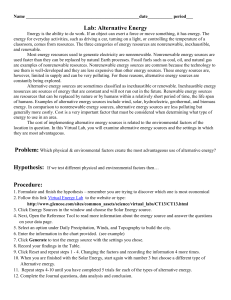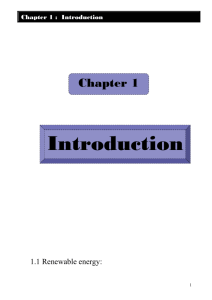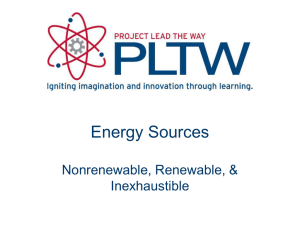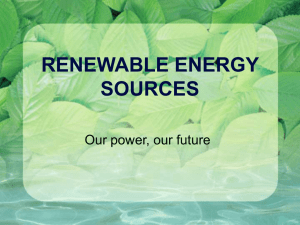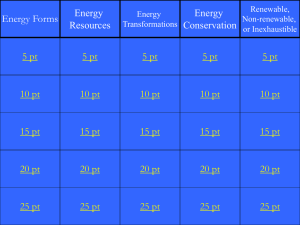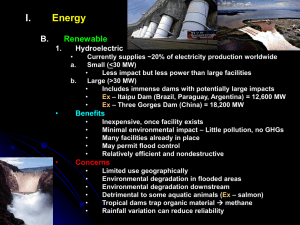Nonrenewable sources of energy
advertisement
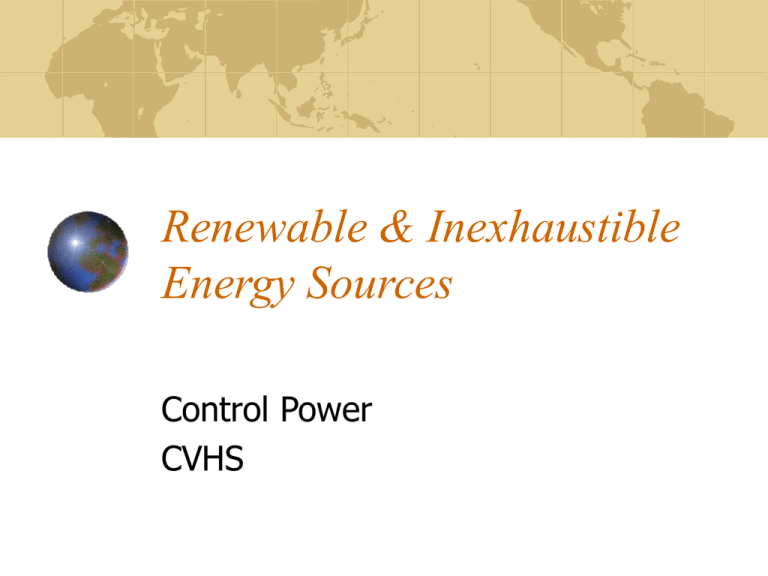
Renewable & Inexhaustible Energy Sources Control Power CVHS Energy vs. Power Energy is defined as “the ability to do work” Power is a term used to describe the measure of work being done (rate) Energy & Society Without energy, Life would not be possible Energy not only powers modern technologies including transportation, etc., but is also necessary to power living organisms (people, animals, plants, etc.) Sources of Energy Nonrenewable Renewable Inexhaustible Nonrenewable Energy This is a source of energy that once used, cannot be replenished Examples: Coal, Natural gas, Nuclear, etc. Renewable Energy This is a source of energy that can be replenished if it is used. Examples: wood, ethanol, food, etc. Inexhaustible Energy This is a source of energy that can be considered permanent (at least for a few million more years). Examples: Sun, Wind, Waves, Geothermal Renewable & Inexhaustible Energy To combat the ill effects, and high costs of nonrenewable energy sources, new technology must be developed. These new energy technologies must heavily rely on renewable and inexhaustible resources in order to be sustainable Renewable Energy Sources Animals Plants Biomass Animals Source of food Source of work energy (especially in underdeveloped countries) Why are animals considered to be renewable and not inexhaustible? Plants: Wood One of the earliest used fuels Despite a decline in the 1900’s, wood is once again a popular choice as a home heating fuel. Can be converted to “wood gas” (methanol) in liquid or gaseous forms Concerns: Trees must be immediately replanted to compensate for long growth periods Burning wood releases pollutants Creosote Build-up Plants: Alcohol Can be produced from a variety of plant life including: Corn, Sugar beats, Sugar cane, and wood. Used to run internal combustion engines, etc. (E85, Regular gas usually includes ~ 10% ethanol) Major Forms: Ethanol & Methanol Concerns: Corn ethanol cuts in on a source of food Still produces pollution Biomass Bioconversion is a process that burns or converts waste organic material into a useable form of energy Incinerators burn biomass to produce electricity Anaerobic Digestion can be used to produce methane gas which can be burned like Natural Gas or Propane Inexhaustible Energy Sources Sun Water Wind Geothermal Sun Most energy sources derive their stored energy from the sun, including plants, trees, wind, etc. The sun provides an almost limitless source of energy that can be collected to produce heat (thermal) or electrical energy. Water: Hydroelectric Used for decades as an energy source for electricity generation Uses the power of moving water to spin a turbine, which turns a generator to produce electricity Most large scale sites have been developed in the US, meaning that only smaller sites may yet be utilized Three Gorges Dam Expected Finished output 22,500 MW Water: Tides & Waves Uses the force of tides and waves to produce electricity Very clean, but may interfere with natural ecosystems, and fishing locations Tide generators can only be used in certain locations Water: OTEC Uses the temperature differential between surface water and deep water (energy stored in water by the sun) Warm water creates steam (spins turbine) cool water condenses steam back into a liquid Can be used to produce electricity at remote ocean locations Problems: Can only be used in certain locations (temp. differential) Dumping large amounts of cold water into the ocean can damage the ecosystem Water: Hydrogen Hydrogen is a very energetic & clean fuel source, but is scarce in its natural state Water molecules can be split to produce Hydrogen and Oxygen Pyrolysis Requires large amounts of energy Two Forms: Electrolysis & Pyrolysis Wind Used for hundreds of years as a mechanical energy source Now used to produce electricity in large scale wind farms, and residential settings Problems Noisy Large areas of land/ sea required Geothermal Uses steam from the earth to spin a turbine and produce Electricity Problems: Loud Smelly May produce Pollution Heat pumps can also be used to heat water to ~ 55° F for home heating Problems Must be used in conjunction with another energy source Conclusions Dependence on Fossil fuels must change sooner or later due to environmental concerns, and the fact that they will someday run out Many forms of energy will need to be implemented to replace fossil fuels Each, has problems associated with it that must be weighed against its benefits
